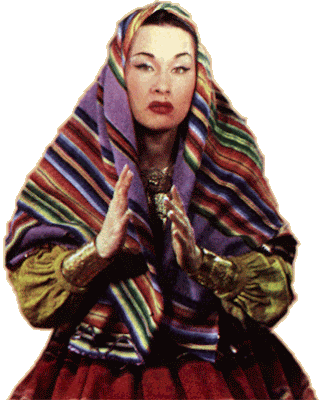





By Adam Bernstein
Washington Post Staff Writer
Monday, November 3, 2008
Yma Sumac, a Peruvian folk entertainer with an astonishing vocal range who surged to fame in the 1950s with an "Incan princess" mystique that captivated millions of record-buyers in search of exotic sounds, died of cancer Nov. 1 at an assisted living facility in the Silver Lake section of Los Angeles. She was believed to be 86, according to personal assistant Damon Devine, who said he had seen the birth certificate.
Nearly every biographical aspect of Ms. Sumac's life was long in dispute, including her age, her town of birth and her ancestral claims that on her mother's side she was a descendant of the last Incan emperor, Atahualpa. Fueled by an intensive publicity machine, the rumors grew so thick at one point that she was jokingly rumored to be a "nice Jewish girl from Brooklyn" who had merely reversed her name, Amy Camus.
Ms. Sumac thrived during a postwar period of American music when the exotic was hip and the composer Eden Ahbez ("Nature Boy") was briefly in vogue. Los Angeles Times music critic Don Heckman once called Ms. Sumac "a living, breathing, Technicolor musical fantasy -- a kaleidoscopic illusion of MGM exotica come to life in an era of practicality." Onstage and off, Ms. Sumac adopted a regal poise and stretched back her raven hair to make her haughty cheekbones even more pronounced. She was fond of flamboyant clothing often laden with gold and silver jewelry, and she spoke of her musical influences among jungle animals.
"At night in my bedroom I hear the whoo-whoo of the little birds and I hear the dogs barking very sad," she told People magazine. "That's what I put in my records. I don't bark bow-wow, but I bark whoo, and I sing like the birdies."
As an interpreter of Andean folk-influenced songs, her voice sailed, growled, roared and yelped effortlessly across four octaves -- from bass to soprano to coloratura soprano. She was adept at mimicking animal calls, from toucans to jaguars, and one never knew where she would dot melody with quick, piercing high-D notes. "She's either got a whistle in her throat or three nightingales up her sleeve," said a bassist with whom she recorded early in her career. Composer Virgil Thomson found her voice "impeccable" and recommended her for "the great houses of opera."
Ms. Sumac extended her heyday through the late 1950s with albums for Capitol Records, selling hundreds of thousands of copies. After headlining in Las Vegas and touring internationally, Ms. Sumac drifted into obscurity by the 1970s. Her older recordings popped up on film soundtracks, ensuring that her sound, if not her name, remained in the popular consciousness.
Zoila Augusta Emperatriz Chavárri del Castillo was born Sept. 13, 1922, possibly in the Andean community of Ichocán. Ms. Sumac said she was self-taught and developed great discipline in breathing technique. She caught the attention of Moisés Vivanco, a musicologist and composer from Lima, and they married in 1942. She joined his 46-member troupe of Indian singers and dancers, became a presence on South American radio and began recording folk music under the name Imma Sumack.
In 1946, Ms. Sumac and her husband started a folk trio that mostly played on the Borscht Belt circuit and the back room of a Greenwich Village delicatessen. Her breakthrough was a 1950 engagement at the Hollywood Bowl, which attracted record and film executives. Her subsequent album, "Voice of the Xtabay" (1950), sold more than 500,000 copies. (The "Xtabay" of the album title was fabricated as an Incan word.)
Other albums followed, including "Mambo!" (1954), with fiery arrangements by Billy May, and "Fuego del Ande" (1959). Many of the songs were composed by her husband and based on Andean folk themes, even if purists found them less than authentic.
She played an Arab princess in a short-lived Broadway musical "Flahooley" (1951) and appeared in the Hollywood films "Secret of the Incas" (1954) with Charlton Heston and "Omar Khayyam" (1957) with Cornel Wilde.
By the early 1960s, her popularity in the United States was waning, but she made a triumphant tour of the Soviet Union in 1961 -- Nikita Khrushchev reputedly was a fan -- and cultivated a small but devoted following in Asia, Europe and Latin America. A comeback album of rock music, "Miracles" (1971), had a limited release, and her appearance on David Letterman's late-night show in 1987 was greeted by sarcasm by the host, who asked "Who is this woman?" after her heartfelt rendition of one of her earliest hits, "Ataypura." Periodic concerts and the 2005 release "Queen of Exotica," a massive anthology of her work, kept her most-fervent fans happy and renewed her cult appeal. The magic-comedy team Penn & Teller used her music to score their stage routines. To some music writers, she was an inspiration to punk and rock performers. "All the big stars came to see Yma Sumac," Ms. Sumac told Newsday in 1989. "What is the name of that one, I think Madonna?"
Ms. Sumac's personal life was troubled at times. Her marriage to Vivanco ended in divorce in 1957 after it was revealed that he had fathered twins with his wife's former secretary. She later told a reporter that Vivanco was "cuckoo," adding, "All men is cuckoo."
Survivors include a son from her marriage, Charlie, and three sisters.




No comments:
Post a Comment